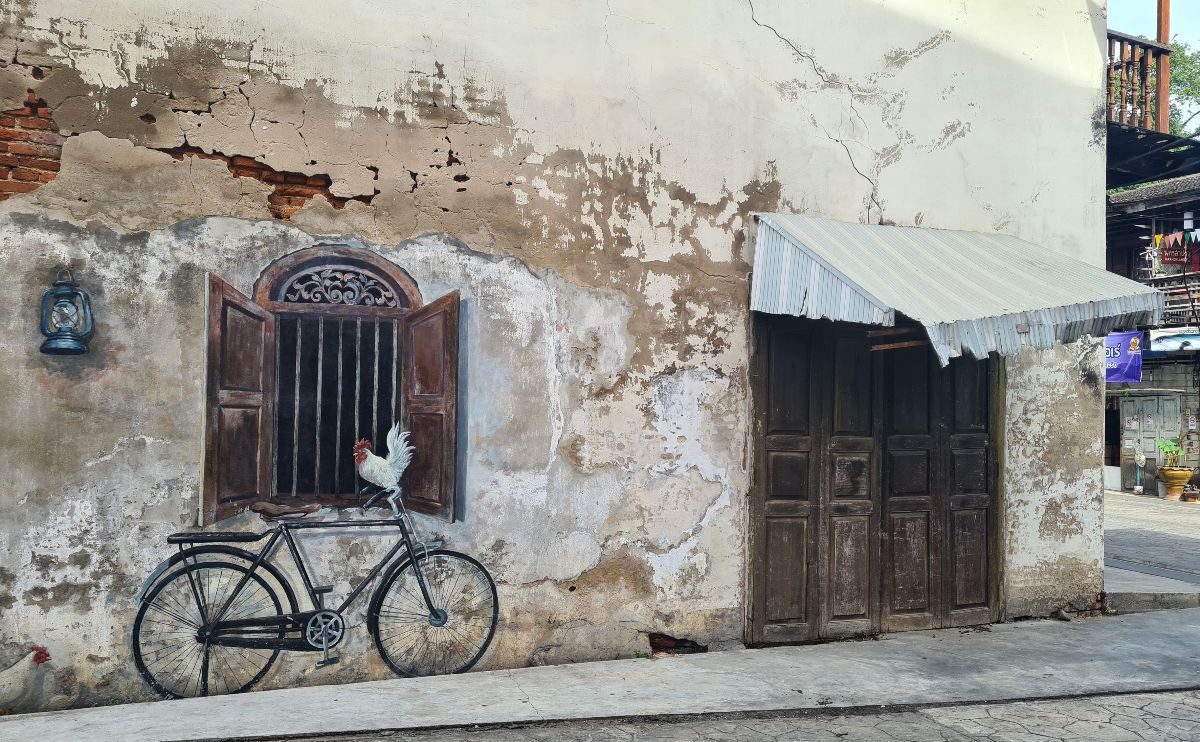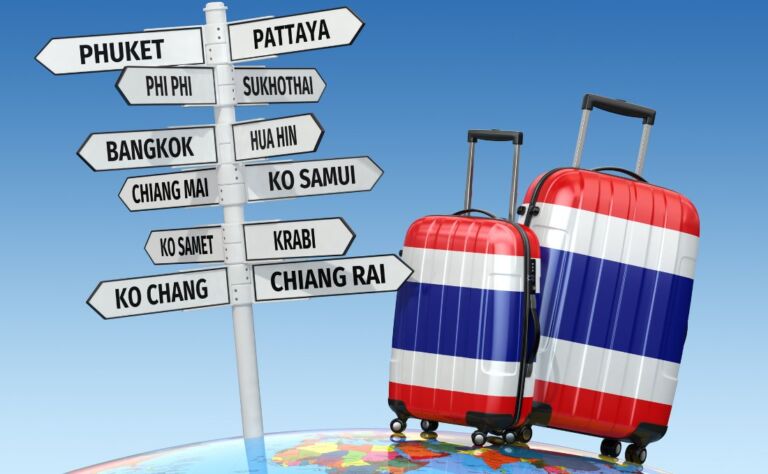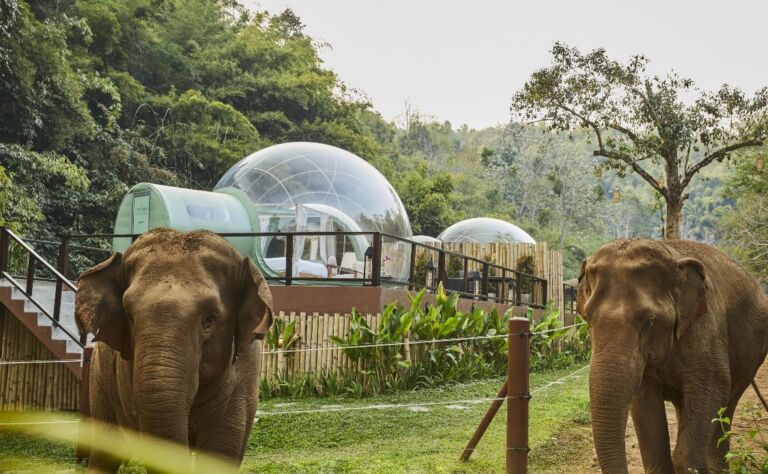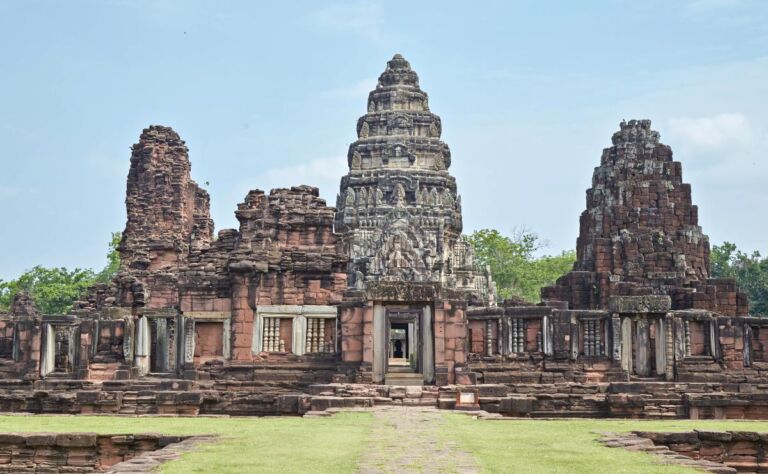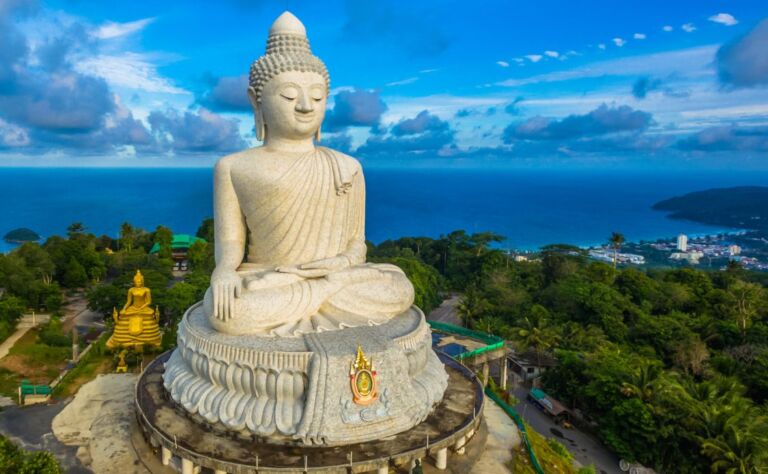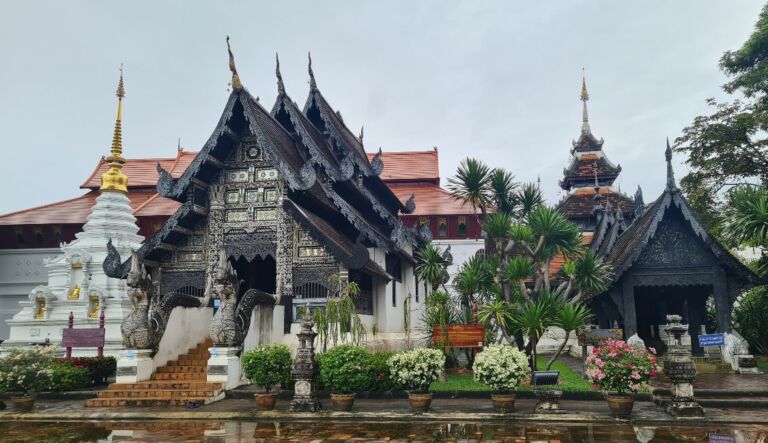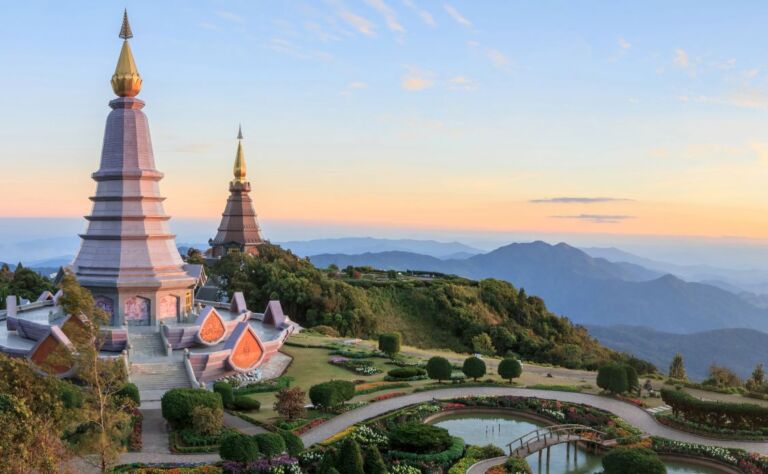Chiang Mai to Lampang: A Weekend in Thailand’s Vibrant North
We recently took a weekend trip from Chiang Mai to Lampang at the suggestion of a local Thai friend and had a fabulous time. The city the perfect place to immerse yourself in Northern Thai life. Just 100km and less than two hours from Chiang Mai this riverside city with its well preserved old town offer plenty to keep you busy for a few days.
Lampang is famous for its stunning teak houses, horse-drawn carriages and ancient temples. The town also has plenty of modern attractions like street art, modern craft beer bars and a fabulous cafe culture.
We fell in love with this less known Northern Thai city and we think you will too!
This page contains affiliate links. Please see our disclosure policy for more details.
Why you should visit Lampang Thailand
You may have not heard of Lampang if this is your first visit to Thailand. It’s not as famous as other cities in the country. However, we think Lampang has a lot to offer, especially if you are keen to see a traditional northern Thai city that is not overrun with tour groups.
The travellers you meet in Lampang are likely to be Thais exploring their own backyard.
We first heard of Lampang over a lunch conversation in a Thai Restaurant in the NSW country town of Mittagong. Our dining partner spoke so highly of Lampang it stayed on our radar and when we started planning a two week northern Thailand road trip, it made the list.
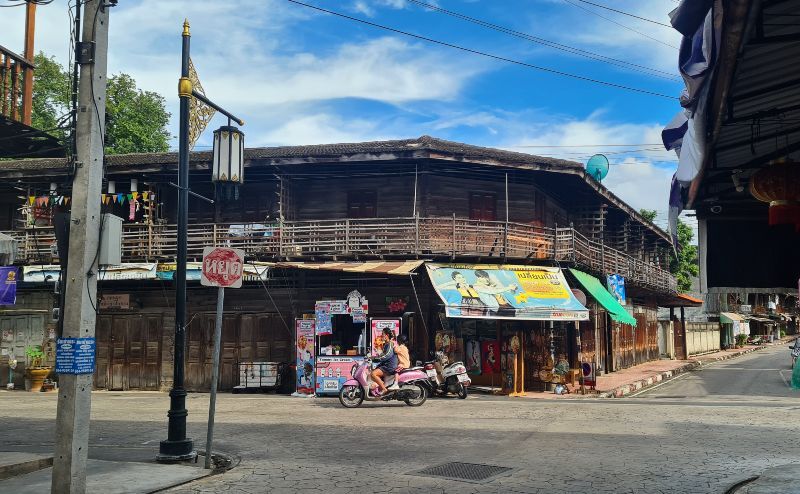
Lampang’s proximity to Chiang Mai and Chiang Rai makes it an easy addition, either as a short getaway from the former or as part of a longer road trip between the two cities, which is what we did.
This city is perfect for anyone wanting to see a more traditional and less touristy side of Thailand.
Where is Lampang
Not to be confused with nearby Lamphun three hours south west, Lampang lies to the southeast of Chiang Mai. This city with a population close to 800,000 is the third-largest in Northern Thailand. It’s located around 100km southeast of Chiang Mai, sitting alongside the picturesque Wang River.
Getting to Lampang
So let’s go over your transport options. Lampang is large enough for its own airport, it’s privately operated by Bangkok Airways, who along with Nok Air offer services from Bangkok.
The flight takes 90 minutes and there are approximately five flights per day. Tickets start range from about US$50-75.
Train From Chiang Mai to Lampang
Three trains a day make the 2 hour 10 minute journey from Chiang Mai to Lampang. While the first train, which is your best bet for a day trip departs at 6.30am, we suggest you aim for the train at 8.50am will get you to Lampang in 1hr 48 minutes. Other trains can take a little longer. The last train leaves Chiang Mai just before 7pm.
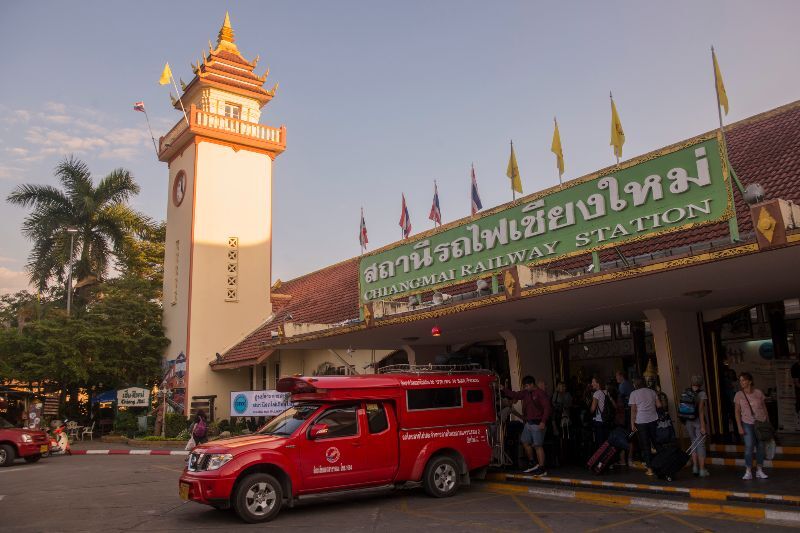
The trip costs 100 baht for an air-conditioned seat or 25 baht for a fan seat. The train station in Lampang is 2.5km or a six minute taxi ride to the centre of old town Lampang.
Bus from Chiang Mai to Lampang
If you prefer a bus ride, head to the Chiang Mai Arcade Bus Station. The direct bus journey to Lampang is faster than the train at only 1 hour 20 minutes. The trip costs about 100 baht.
There are a couple of bus companies servicing the route. Most of the buses going south from Chiang Mai will stop in Lampang Province. The first bus departure is at 7.25am and the last bus leaves at 9.50pm.
Buses arrive in Lampang Bus terminal which is about is 2km distance or 4 minutes in a taxi to the old town. Ticket prices for passengers are about $4-5.
Drive to Lampang Province
For our trip from Chiang Mai to Lampang, we decided to rent a car. We found the roads were in great condition and the traffic was easy to navigate. As Thais drive on the same side as us (Aussies) it was a breeze.
It takes about 90 minutes to get from Chiang Mai to the centre of Lampang. If you don’t want to drive, you can book a taxi for between $60-$80, less if you use the InDrive app and book in advance.
If you map your route carefully, you can include some impressive sites on the way to and from Lampang.
Regardless of which way you choose there is no need to stress, you will find plenty of transport options for travelling between Chiang Mai and Lampang.
What is Lampang known for?
Teak houses, roosters and the horse and carriage are the three top things that people visit Lampang to see.
You will notice white roosters as you explore the town. This is the town’s mascot. Thankfully, you will also see quite a lot of teak houses remain in the old town.
Lampang is also called “mueang rot ma” in Thai, meaning “horse carriage city”
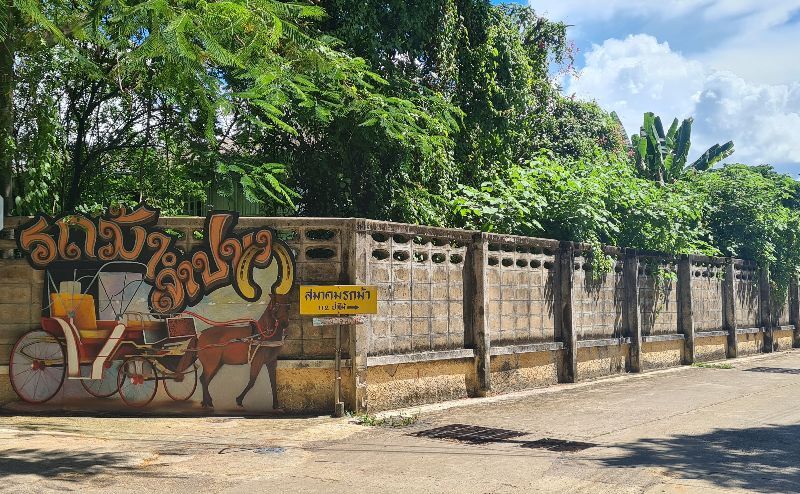
When is the best time to go to Lampang?
Like Chiang Mai, Lampang is best visited in the winter between November and February.
We would not recommend visiting between March and May when the weather is ridiculously hot and the pollution from the burning season makes things pretty hard to enjoy. I would say most people would not have liked to attempt the hikes we did in smoky air.
We went in October and that was lovely–anytime from then until late January would be ideal. Alternatively, late April until early June would be our second choice.
The walking streets in Lampang were some of our favourites all our one month road trip around Northern Thailand.
You should try to include at least one of Lampang’s weekend nights. We stayed Friday to Monday and enjoyed all three markets, the Friday, Saturday night markets and Sunday walking street market.
If I had to pick just one, I would go with Sunday, which was bigger, but the Friday was more local and offered a different feel to many markets we visited across the country.
How many days do you need to see Lampang?
I think three days is ideal. Along with wonderful food, some fun street art and a couple of epic night markets, within an hour’s drive of the city centre are three temples to rival the more famous ones in Chiang Rai and two pristine national parks with waterfalls and hiking trails to explore.
If you are happy to just see the old town and major attractions of Lampang, you could cover these in one or two days, but there is plenty to see in the surrounding areas.
The weekend markets are also an attraction in their own right so if you can time it to spend at least a one night over the weekend in town.
The old town comes alive after dark on weekends, with locals descend on the night markets in their hundreds. We saw very few international visitors during our three-night stay.
Where to stay in Lampang?
A base near Ratsadapisek Bridge is handy if you plan to explore on foot. We stayed on the side opposite the old town, which was perhaps a little quieter, but really either side is fine.
Kanecha’s Home Lampang – Budget
We spent our three nights at Kanecha’s Home Lampang, which we found after booking a nearby hotel that looked much grander but turned out to be very uncomfortable. Kanecha’s feels like a self contained homestay experience and everyone we met was lovely. You share a common garden and a small covered outdoor area down by the water.
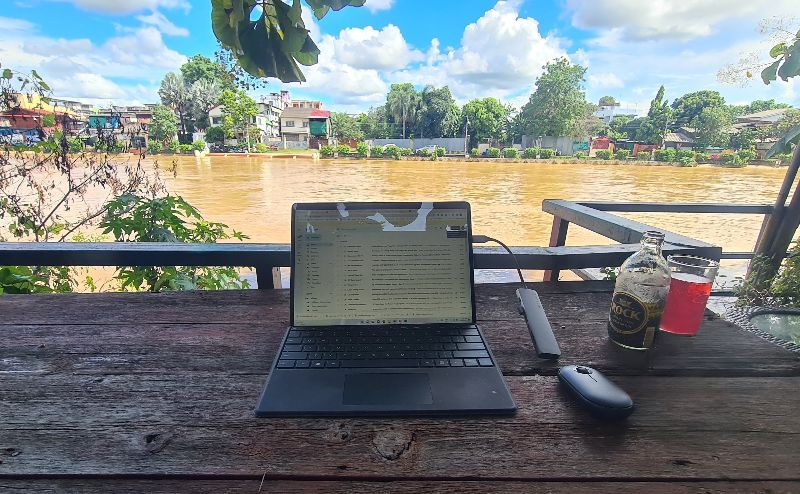
There were a couple of cabins like buildings. Ours featured a larger apartment upstairs and our room downstairs. The rooms were rustic, but the bed was super comfortable and the air conditioning was strong and quiet. I would stay again.
Check the prices and styles of the rooms here
Pangsuree Art Home
During our stay, we grabbed our morning coffee at Pangsuree Art Home and got chatting with the friendly owner. Along with delicious coffee and beautiful cakes, they offer a number of very nicely decorated rooms right on the main walking street and backing onto the river.
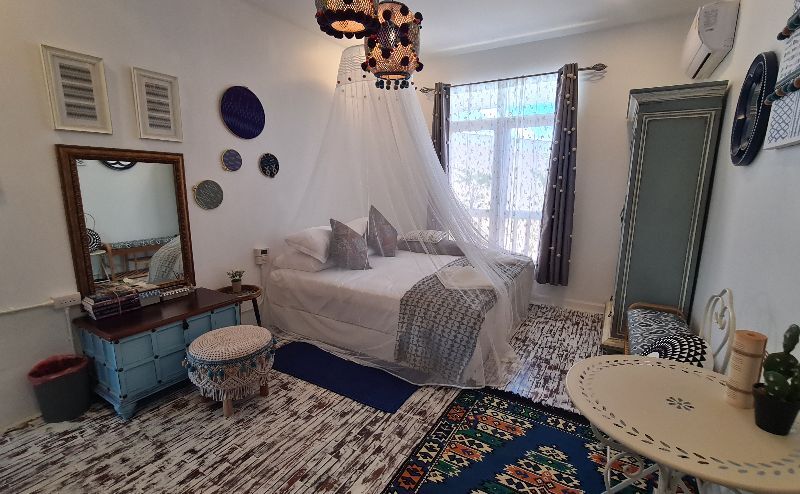
The rooms are located above the cafe which is a bridge new building. The rooms are decorated with artworks, many made by the owner’s wife and they have a very comfortable feel.
There are a variety of rooms, from king spa rooms to a large family suite. There are no special facilities but there is a garden area that runs down to the river and you are right in the centre of the old town.
We would definitely stay here if we were to return.
Check the current price and room availability of this beautiful local property
River Lodge Hotel
For those looking for a more upscale option, consider Lampang River Lodge, a tranquil retreat located just off Paholyothin Road about 10km from the centre of Lampang.
Featuring Lanna-style bungalows, each with air-conditioning, a private terrace, and a living area with garden views. If you are looking to relax on your getaway, this might be a good choice. The large swimming pool and well-maintained lush garden with ancient trees enhance the peaceful atmosphere. The property is showing sizes of aging and the rooms could do with some updating, but it’s still quite lovely.
Find out more about this hotel here
What to see and do in Lampang
I pleasantly surprised us about how much there was to keep us busy on our short visit. We think 2-3 days is a good amount of time to allow for a visit to Lampang, although if you want to explore the surrounding national parks, you may want to allow longer.
Kat Kong Ta Walking Street – Weekends
If you’re looking for a fun and lively atmosphere, head to Lampang Walking Street. This night market is held every Saturday and Sunday. It’s a great place to try local street food, shop for souvenirs, and enjoy live music and entertainment.
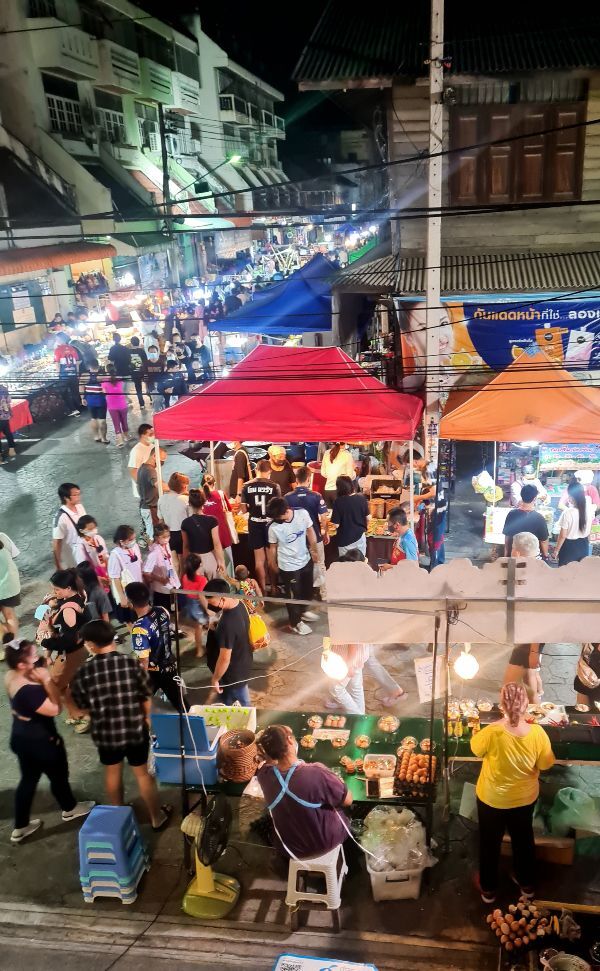
The markets stretch of four blocks and extend into the adjacent lanes. It’s different from the markets of nearby Chiang Mai’s markets with a more local vibe and cheaper prices. It’s also a cultural hotspot, where young artists showcase their painting skills, musicians captivate the public with performances, and other lively activities contribute to the market’s vibrant ambiance.
Try to visit the street on another day to enjoy the gorgeous architecture and visit some cafes and restaurants on the street.
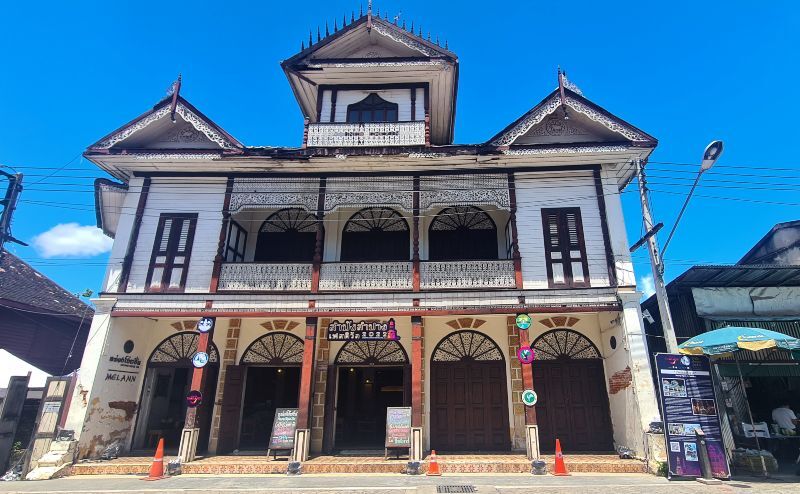
When: Saturday-Sunday 5-10pm although Sundays it starts shutting down around 9pm.
Where: Talad Gao Rd, Mueang Lampang District, Lampang
Lampang Cultural Street Market – Friday
The Lampang Cultural Street Market becomes a lively cultural hotspot every Friday. This authentic local market isn’t just for tourists – it’s the place where residents really do their shopping. It’s a brilliant way to get a true feel of local life, and is a must-see for every visitor.
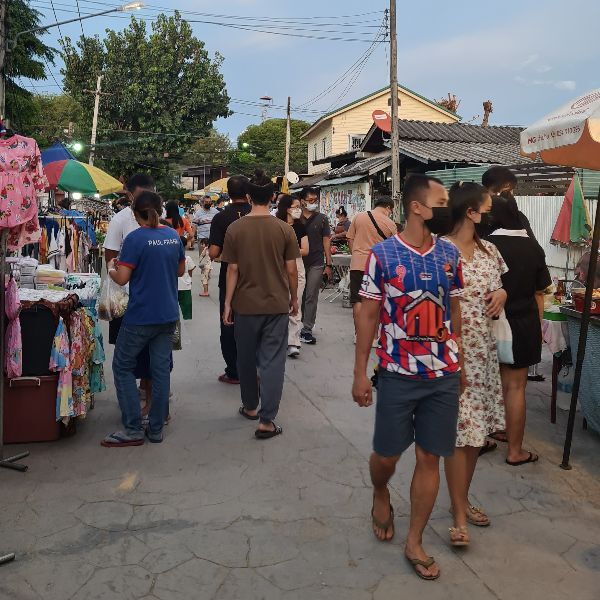
The market is smaller than the weekend market, but it still spans several blocks, and offers a more diverse range of products. You’ll find everything from fresh fruits and vegetables to clothes and home decor. The food offerings were more local and unfamiliar, making it even more interesting for us!
About half way along the market street, you will come across some ancient temple ruins which are light up at night.
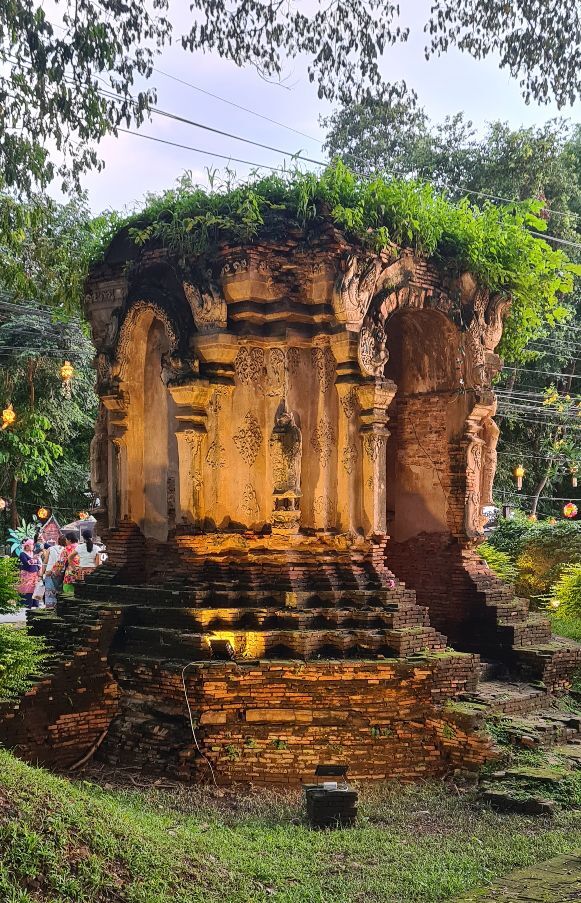
We enjoyed the local entertainment and happy, relaxed vibe.
When: Fridays 4:30pm-9pm
Where: Wang Nuea, Wiang Nuea, Mueang Lampang District, Lampang
Wat Chaloem Phra Kiat Phrachomklao Rachanusorn
The Wat Phraphutthabat Sutthawart, also known as the “Jedee Loy Fah” or “Floating Pagodas Temple,” is located approximately 80 kilometres from Lampang, a city in Northern Thailand, within Lampang Province.
These striking white pagodas, seemingly age-old, are actually a modern addition, only completed in 2015.
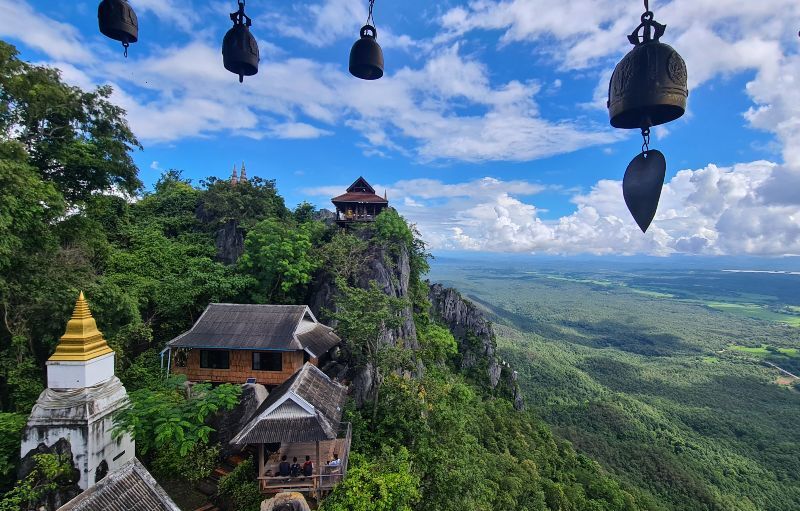
Constructed to celebrate the bicentennial of King Rama IV’s reign, the temple was a labour of love for a dedicated team of 50 volunteers. The construction spanned nine years, a testament to their perseverance given the challenging landscape.
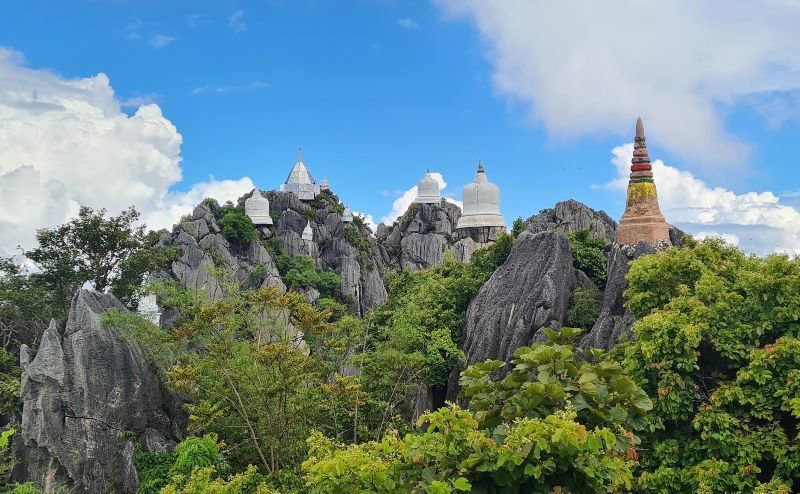
Perched on rugged limestone cliffs, the pagodas stand tall above the Chae Hom Valley. At an elevation of 838 meters and 500 meters above the road, the journey to reach requires a bit of effort.
We arrived at 8am for our visit and joined a family of local Thai visitors. It was warm but the staircases are quite new and for the most part the track has good tree coverage. If you have average fitness, you will be fine, but there are plenty of places to stop and rest along the way so just take your time and walk at your own pace. The reward is breathtaking 360-degree views and on our early morning visit lots of tranquillity.
If you don’t have a car or motorbike, you can book a local driver or take a guided tour
Wat Doi Prachan Mae Tha Temple
If you have been to Japan, you have may have seen the Kamakura Buddha just outside of Tokyo. This version popped up in Lampang in 2019. But there is more to Wat Doi Prachan than this stunning blue Buddha.
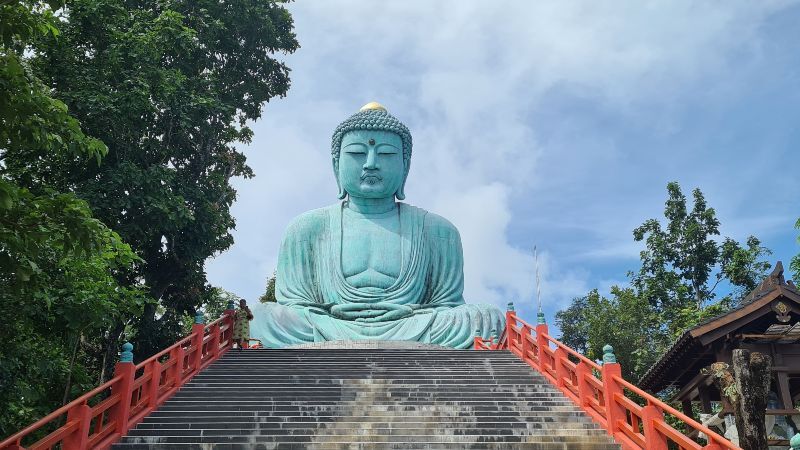
If you visit on the weekend, you can take a ride from the entry to the top of the temple. If not, you face about 600 stairs to reach the top.
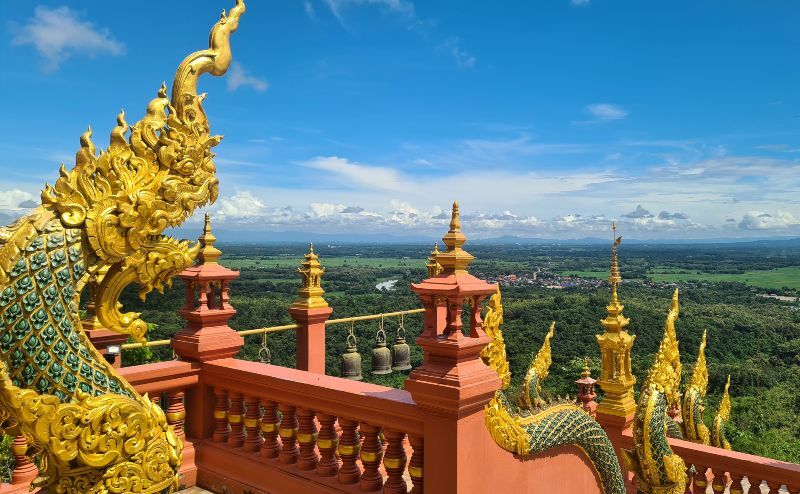
We were lucky and scored the ride up; I don’t remember the price but was very cheap and well worth it. When we decided to visit it was to see the blue Buddha, we didn’t realise there was an entire temple waiting for us that was every bit as beautiful.
When: 6am-4:30pm
Where: The temple is 20km south of Lampang city.
Stroll the street art walls just before sunset
If you enjoy street art, you will love Lampang. There is plenty of it across the old town and an official street art area along the river bank on the city side of the river.
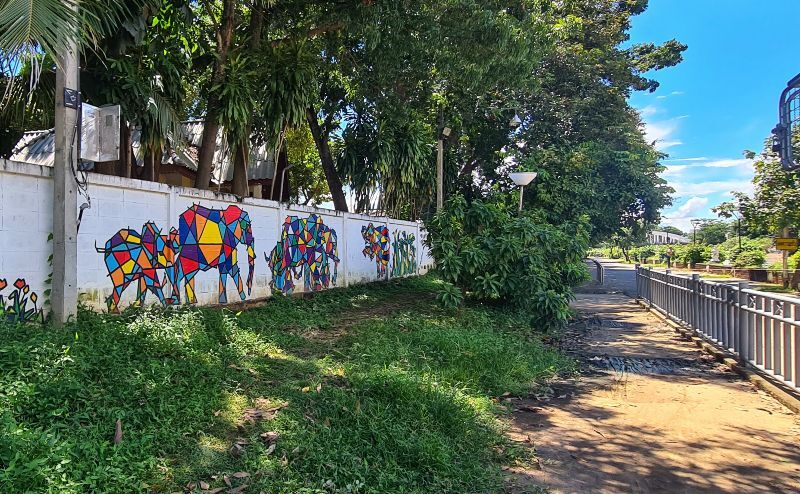
Much of the work features references to cultural features of Lampang, like the famous roosters and elephants. The art tends more to fun than political statement.
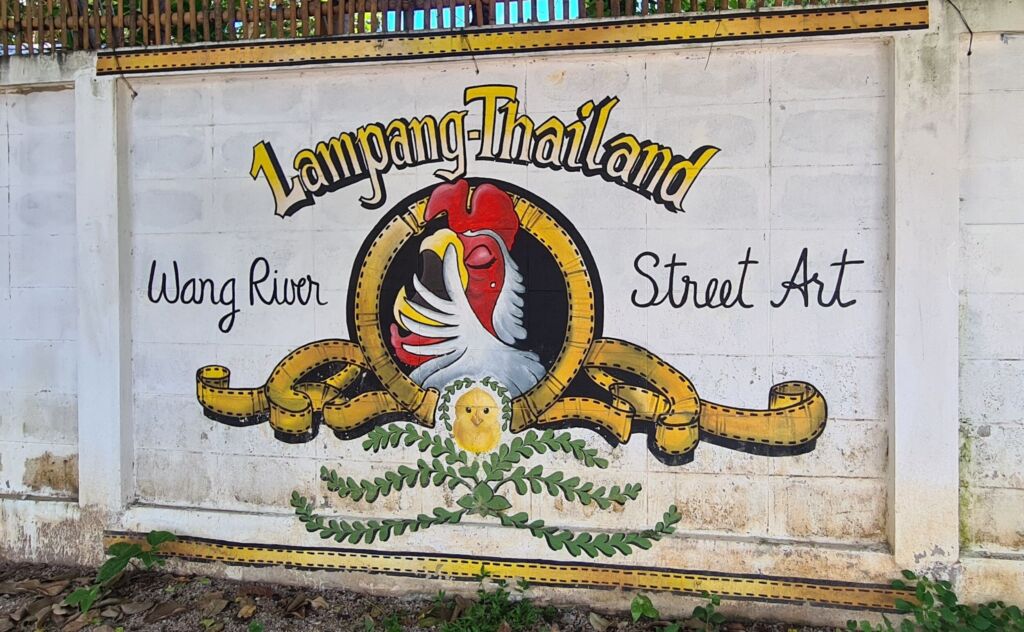
Walk along the riverbank street (Sri-Kird Rd) between the Ratsada Phisek Bridge and the pedestrian and motorbike bridge on Tippawan Road. Wander up Tippawan Road into the old town for more murals that are similar to the ones we had seen in Penang.
See our album on Facebook for more photos of the murals in Lampang.
Visit Baan Sak Nak
For those interested in history and architecture, a visit to Baan Sao Nak is a must. This historic house was built in the 19th century and features traditional Thai Lanna-style architecture. Visitors can take a guided tour of the house and learn about its history and the people who once lived there.
Chae Son National Park
Wang Kaeo Waterfall and the Chae Son National Park, a compact park which combines a natural hot spring with large waterfalls. Sadly, we didn’t have time to explore here but wish we had allowed an extra day.
FAE Elephant Hospital
Located just outside of Lampang, the Friends of the Asian Elephant Foundation was established in 1994 to treat sick and injured elephants. It was the first Asian Elephant hospital in the world and the only place in Lampang that we recommend you go to see elephants.
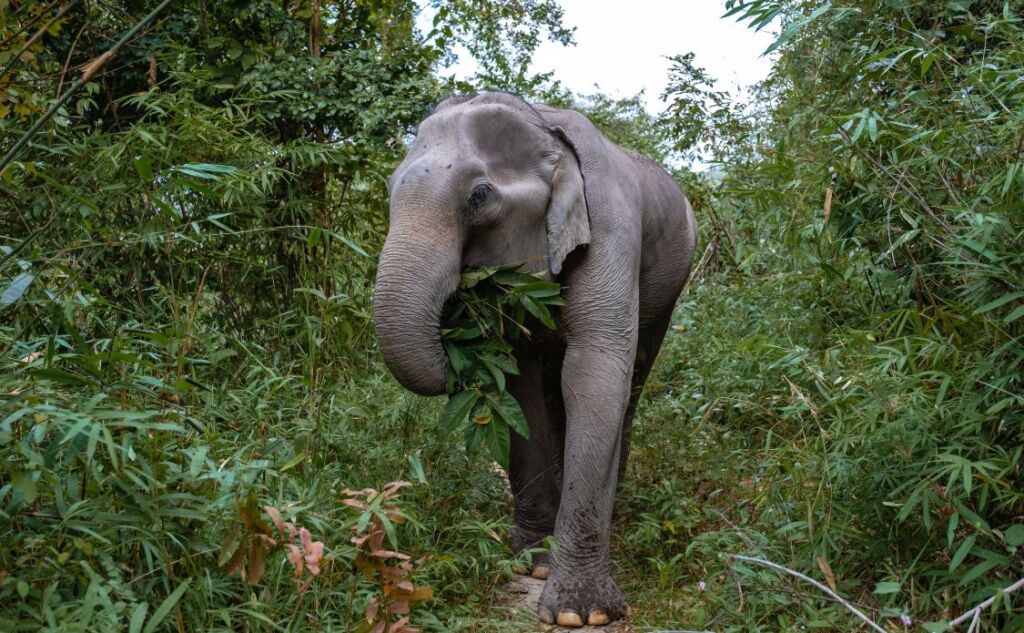
There are nine long-term resident elephants and others who are receiving treatment before they return to their homes.
Visitors can observe the elephants but in keeping with ethical guidelines, there are no activities like feeding and bathing.
Where: 295 Moo 6 Lampang-Chiangmai Road Viengtan Hangchatr Lampang
Horse-Drawn Carriage Ride
A horse-drawn carriage ride is said to be a must-do activity in Lampang. We decided against it but these traditional carriages are a symbol of the city and offer a unique way to explore the streets.
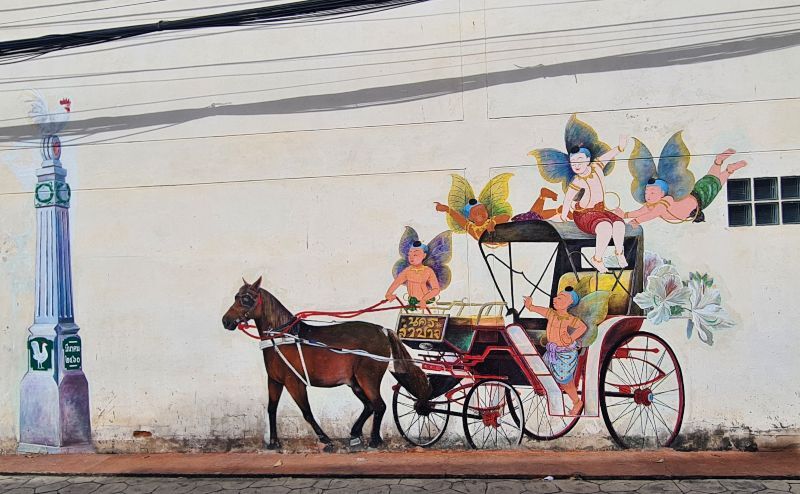
We hope this guide has convinced you that Lampang is a wonderful destination to add to your itinerary when you travel to Northern Thailand. It really is a little off the international tourist trail, so if you are keen to support more sustainable tourism by exploring less visited places, I am sure you won’t be disappointed with a stop here.
Want more advice about exploring this part of Thailand? Check out our guide to tours in Doi Inthanon National Park, waterfalls near Chiang Mai or the temples of Chiang Mai.
Ready to start planning your Thailand trip? Our Facebook community Thailand Awaits is here to help. Join fellow travellers, get your questions answered by Thailand experts, and access free planning resources.

